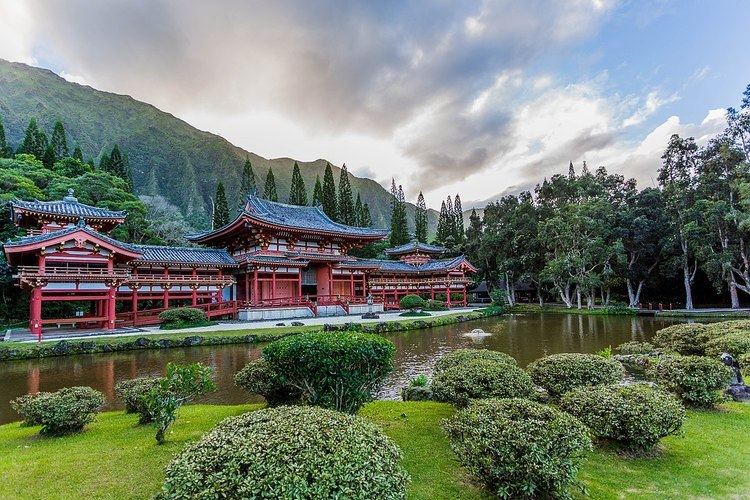Affiliation non-denominational Completed 1968 Phone +1 808-239-9844 | Country United States Opened 1968 | |
 | ||
Location 47-200 Kahekili Hwy
Kaneohe, HI 96744 Address 47-200 Kahekili Hwy, Kaneohe, HI 96744, USA Similar Kualoa Ranch, Dole Plantation, Koʻolau Range, Nu‘uanu Pali, Ho'omaluhia Botanical Garden | ||
The Byodo-In (平等院) Temple is a non-denominational temple located on the island of O'ahu in Hawai'i at the Valley of the Temples. It was dedicated in August 1968 to commemorate the 100-year anniversary of the first Japanese immigrants to Hawaii. The temple is a replica of a 900-year-old Buddhist temple at Uji in Kyoto prefecture of Japan. Contrary to popular belief, it is not a functioning Buddhist temple in the proper sense as it does not host a resident monastic community nor an active congregation. Inside the Byodo-In Temple is a 18 ft (5.5 m) statue of the Lotus Buddha, a wooden image depicting Amitabha. It is covered in gold and lacquer. Outside is a three-ton, brass peace bell. Surrounding the temple are large koi ponds that cover a total of two acres (8,000 m²). Around those ponds are lush Japanese gardens set against a backdrop of towering cliffs of the Ko'olau mountains. The gardens are home to sparrows and peacocks. The temple covers 11,000 sq ft (1,000 m2).
Contents
The Byodo-In Temple is visited and used by thousands of worshipers from around the world. It welcomes people of all faiths to participate in its traditions. Apart from worship, the temple grounds are also used for weddings and office meetings.
Byodo in temple oahu hawaii
Ancient Japan
Byodo-In Temple is a half-size-scale replica of the Byodo-in Temple, a United Nations World Heritage Site near the ancient city of Kyoto, originally a monastery founded by Fujiwara no Yorimichi in 1052 of the Heian period. It was famous for its Vairochana statue. The statue was lost and replaced in 1053 with a large wooden statue of Amitabha (Amida Nyorai), a national treasure of the Empire carved by the Japanese artisan Jocho. Amitabha stands in the midst of the Phoenix Hall or Hoodo, an artistic reproduction of Amitabha Tathagata's Western Pure Land. It is called Phoenix Hall in reference to the two phoenixes stretching their wings upon the temple roof. Fifty two wooden images of Bodhisattvas surround the Amidtabha, dancing and playing musical instruments on floating clouds.
From 2001 to 2007, the temple underwent restoration in the spirit of preservation of Japan's ancient heritage.
Modern Hawai'i
Byodo-In Temple was commissioned and built largely by concrete (the original is wooden without the use of nails) in 1968 at its present location in the Valley of the Temples to celebrate the centennial anniversary of the arrival of Japanese culture to Hawai'i. It was dedicated by Governor John A. Burns, a favorite of the Japanese community for his long service for the cause of Japanese rights during the state's territorial years. Japanese immigrants entered the Kingdom of Hawai'i and later Territory of Hawai'i to labor in the sugarcane and pineapple plantations. They joined the Chinese, Filipino, Korean, native Hawaiians and Portuguese.
Byodo-In Temple previously housed the remains of Philippine dictator Ferdinand Marcos. His body was held in a mausoleum until it was moved back to the Philippines where it is now held in a refrigerated tomb.
In popular culture
The TV series Hawaii Five-O and Magnum, P.I. featured several episodes where the temple is incorporated into the plot. The temple and its vicinity also served as a stand-in for South Korea in one episode of the ABC series Lost and as the Presidential Villa in an episode of seaQuest DSV.
The temple was also used in the 2001 movie Pearl Harbor as a replica of the Byodo-In Temple in Japan as well as several other movies.
